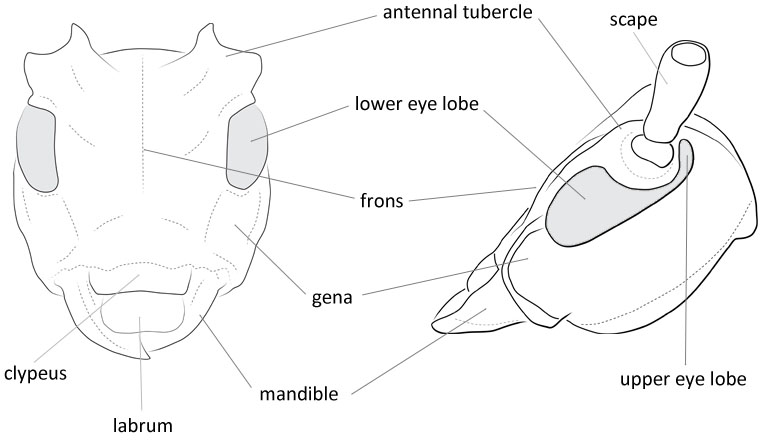Body length: 12–31 mm.
Eyes: eye interommatidial setaeseta:
a sclerotized hair-like projection of the cuticle
absent, eye deeply emarginateemarginate:
notched at the margin > half width, eye ommatidial density coarse or fine.
> half width, eye ommatidial density coarse or fine.
Antennaeantenna:
in larval and adult insects, paired segmented appendages, borne one on each side of the head, functioning as sense organs and bearing a large number of sensilla
: antennal length reaches between basebase:
the part of any appendage or structure that is nearest the body
and end of elytraelytron:
the leathery forewing of beetles, serving as a covering for the hind wings, commonly meeting opposite elytron in a straight line down the middle of the dorsum in repose
, antennal flagellar segments elongateelongate:
much longer than wide
, scapescape:
the first proximal segment of the antenna cicatrix (scar) at apexapex:
cicatrix (scar) at apexapex:
end of any structure distad to the base
, antennal scapescape:
the first proximal segment of the antenna ≥ segment 3.
≥ segment 3.
Pronotumpronotum:
the upper and dorsal part of the prothorax
: pronotumpronotum:
the upper and dorsal part of the prothorax
shape transversetransverse:
broader than long
, pronotumpronotum:
the upper and dorsal part of the prothorax
lateral armature acute spinespine:
a protuberance with an acute (sharp) distal end
.
Prosternum: prosternal processprosternal process:
a posterior extension of the prosternum between the coxae dilated at apexapex:
dilated at apexapex:
end of any structure distad to the base
, procoxal cavities closed posteriorly.
Elytraelytron:
the leathery forewing of beetles, serving as a covering for the hind wings, commonly meeting opposite elytron in a straight line down the middle of the dorsum in repose
: elytral length reaching or close to end of abdomen, elytral apicesapex:
end of any structure distad to the base
rounded or truncatetruncate:
cut off squarely at the tip
, elytral color black or brown, elytral color pattern absent.
Legs: visible tarsomerestarsomere:
subdivision or article of the tarsus, usually numbering from two to five : 4, femora robust, protibial spursprotibial spur:
: 4, femora robust, protibial spursprotibial spur:
sclerotized spine(s) located at the distal tibia; can be single, double, or absent : 2, tarsal clawstarsal claw:
: 2, tarsal clawstarsal claw:
usually paired claws of the pretarsus, at the distal end of the leg simple.
simple.
Body thick, stocky, with minute adherent yellowish-golden hairs imparting bronze tone. Antennaeantenna:
in larval and adult insects, paired segmented appendages, borne one on each side of the head, functioning as sense organs and bearing a large number of sensilla
shorter than body, extending beyond middle of elytraelytron:
the leathery forewing of beetles, serving as a covering for the hind wings, commonly meeting opposite elytron in a straight line down the middle of the dorsum in repose
. Elytraelytron:
the leathery forewing of beetles, serving as a covering for the hind wings, commonly meeting opposite elytron in a straight line down the middle of the dorsum in repose
on disk in anterior half with smooth black grains (Cherepanov 1990Cherepanov 1990:
Cherepanov AI. 1990. Cerambycidae of Northern Asia, Vol. 3. Lamiinae, Part I. Oxonian Press, New Delhi 4: i–xiii + 1–300, 120 figs.).
Lamiomimus, Morimus
Lamia does not have any maculaemacula:
a spot or mark
on the elytraelytron:
the leathery forewing of beetles, serving as a covering for the hind wings, commonly meeting opposite elytron in a straight line down the middle of the dorsum in repose
.
Neotropical (Brazil, L. annulicornis), Palearctic (L. textor)
Has been intercepted at USA ports
broadleaf trees; Pinaceae recorded as well
2 species. Lamia annulicornis is incerte sedis in Lamiinae so likely belongs elsewhere.
Pachystola Dejean, 1835
Morimidus Thomson, 1859
Lamia Fabricius, 1775